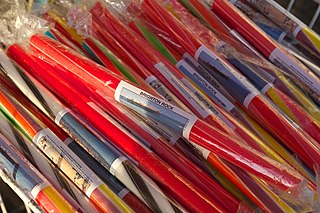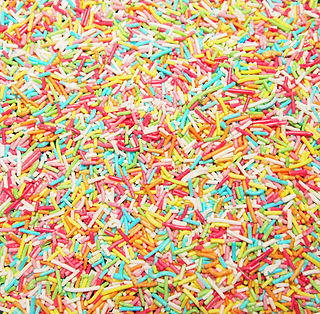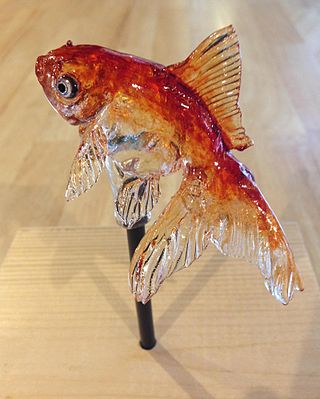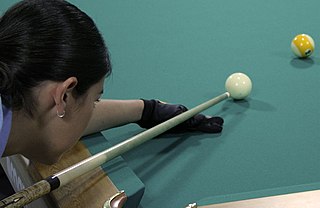
Components of an electrical circuit are electrically connected if an electric current can run between them through an electrical conductor. An electrical connector is an electromechanical device used to create an electrical connection between parts of an electrical circuit, or between different electrical circuits, thereby joining them into a larger circuit. Most electrical connectors have a gender – i.e. the male component, called a plug, connects to the female component, or socket. The connection may be removable, require a tool for assembly and removal, or serve as a permanent electrical joint between two points. An adapter can be used to join dissimilar connectors.

Rock is a type of hard stick-shaped boiled sugar confectionery most usually flavoured with peppermint or spearmint. It is commonly sold at tourist resorts in the United Kingdom and Ireland ; in Gibraltar; in Denmark in towns such as Løkken and Ebeltoft; and in Sydney and Tasmania, Australia.

A candy cane is a cane-shaped stick candy often associated with Christmastide, as well as Saint Nicholas Day. It is traditionally white with red stripes and flavored with peppermint, but the canes also come in a variety of other flavors and colors.

Scissors are hand-operated shearing tools. A pair of scissors consists of a pair of blades pivoted so that the sharpened edges slide against each other when the handles (bows) opposite to the pivot are closed. Scissors are used for cutting various thin materials, such as paper, cardboard, metal foil, cloth, rope, and wire. A large variety of scissors and shears all exist for specialized purposes. Hair-cutting shears and kitchen shears are functionally equivalent to scissors, but the larger implements tend to be called shears. Hair-cutting shears have specific blade angles ideal for cutting hair. Using the incorrect type of scissors to cut hair will result in increased damage or split ends, or both, by breaking the hair. Kitchen shears, also known as kitchen scissors, are intended for cutting and trimming foods such as meats.

The art of paper cutting in China may date back to the 2nd century CE, when paper was invented by Cai Lun, a court official of the Eastern Han dynasty.

Pliers are a hand tool used to hold objects firmly, possibly developed from tongs used to handle hot metal in Bronze Age Europe. They are also useful for bending and physically compressing a wide range of materials. Generally, pliers consist of a pair of metal first-class levers joined at a fulcrum positioned closer to one end of the levers, creating short jaws on one side of the fulcrum, and longer handles on the other side. This arrangement creates a mechanical advantage, allowing the force of the grip strength to be amplified and focused on an object with precision. The jaws can also be used to manipulate objects too small or unwieldy to be manipulated with the fingers.
A lollipop is a type of sugar candy usually consisting of hard candy mounted on a stick and intended for sucking or licking. Different informal terms are used in different places, including lolly, sucker, sticky-pop, etc. Lollipops are available in many flavors and shapes.

Sprinkles are small pieces of confectionery used as an often colourful decoration or to add texture to desserts such as brownies, cupcakes, doughnuts or ice cream. The tiny candies are produced in a variety of colors and are generally used as a topping or a decorative element. The Dictionary of American Regional English defines them as "tiny balls or rod-shaped bits of candy used as a topping for ice-cream, cakes and other."

Candy apples are whole apples covered in a sugar candy coating, with a stick inserted as a handle. These are a common treat at fall festivals in Western culture in the Northern Hemisphere, such as Halloween and Guy Fawkes Night because these festivals occur in the wake of annual apple harvests. Although candy apples and caramel apples may seem similar, they are made using distinctly different processes.

Christmas ornaments, baubles, globes, "Christmas bulbs", or "Christmas bubbles" are decoration items, usually to decorate Christmas trees. These decorations may be woven, blown, molded, carved from wood or expanded polystyrene, or made by other techniques.

Christmas cookies or Christmas biscuits are traditionally sugar cookies or biscuits cut into various shapes related to Christmas.

A violin consists of a body or corpus, a neck, a finger board, a bridge, a soundpost, four strings, and various fittings. The fittings are the tuning pegs, tailpiece and tailgut, endpin, possibly one or more fine tuners on the tailpiece, and in the modern style of playing, usually a chinrest, either attached with the cup directly over the tailpiece or to the left of it. There are many variations of chinrests: center-mount types such as Flesch or Guarneri, clamped to the body on both sides of the tailpiece, and side-mount types clamped to the lower bout to the left of the tailpiece.

Barley sugar is a traditional variety of boiled sweet, often yellow or orange in colour, which is usually made with an extract of barley, giving it a characteristic taste and colour. In Britain it is usually sold in the shape of twisted sticks. Barley sugar is very similar to clear toy candy and to hard caramel candy in its texture and taste.

Sugar sculpture is the art of producing artistic centerpieces entirely composed of sugar and sugar derivatives. These were very popular at grand feasts from the Renaissance until at least the 18th century, and sometimes made by famous artists. Sugar was very expensive by modern standards, and sculptures in it a form of conspicuous consumption, reflecting wealth. Today, there are many competitions that include sugar sculpture.

Amezaiku (飴細工) is Japanese candy craft artistry. An artist takes multi-colored mizuame and, using their hands and other tools such as tweezers and scissors, creates a sculpture. Amezaiku artists also paint their sculpted candy with edible dyes to give the finished work more character. Animals, including goldfish and insects, are common amezaiku shapes created to appeal to children. Intricate animal characters are created with expert speed. Some amezaiku artists are also street performers who perform magic tricks and tell stories along with their candy craft entertainment.

Polkagris is a Swedish stick candy that was invented in 1859 by Amalia Eriksson in the town of Gränna, Sweden. It remains a well-known albeit old-fashioned candy in Sweden, often sold at fairs, Christmas markets, and the like. It is still closely associated with Gränna. The traditional polkagris candy stick is white and red, and is peppermint-flavoured.
Hairstyling tools may include hair irons, hair dryers, hairbrushes, hair rollers, diffusers and various types of scissors.

A cue stick is an item of sporting equipment essential to the games of pool, snooker and carom billiards. It is used to strike a ball, usually the cue ball. Cues are tapered sticks, typically about 57–59 inches long and usually between 16 and 21 ounces (450–600 g), with professionals gravitating toward a 19-ounce (540 g) average. Cues for carom tend toward the shorter range, though cue length is primarily a factor of player height and arm length. Most cues are made of wood, but occasionally the wood is covered or bonded with other materials including graphite, carbon fiber or fiberglass. An obsolete term for a cue, used from the 16th to early 19th centuries, is billiard stick.

Candy making or candymaking is the preparation and cookery of candies and sugar confections. Candy making includes the preparation of many various candies, such as hard candies, jelly beans, gumdrops, taffy, liquorice, cotton candy, chocolates and chocolate truffles, dragées, fudge, caramel candy, and toffee.

















